
ANISE, STAR (poy kak bua)
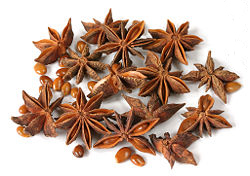
The tan-colored pods with eight points, like stars, come from trees in the Magnolia family. Used in Thailand primarily in dishes of Chinese origin, star anise is unrelated to anise, but imparts a similar licorice flavor to dishes. Commonly found in Five-Spice Powder, it is more often added whole to curries and soups.
BAMBOO SHOOTS (nor mai)

The young shoots of the bamboo plant. Available in many different sizes and forms. The most common is canned, however you can usually find them fresh soaking in some water at an Asian supermarket. They are pale yellow in color and usually crispy and crunchy to the taste with a mild flavor. They are used for color, texture, and flavor in many Thai dishes. We recommend soaking them in cold water with some salt for at least 20 minutes to lessen any canned or stale taste. They will keep in the refrigerator for up to two weeks in water. The water should be changed daily.
BANANA LEAVES (bai tong)
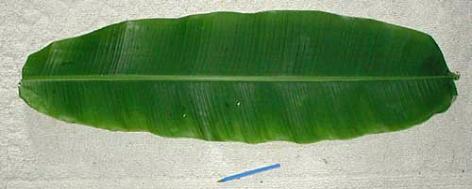
In Thai cooking, banana leaves are used to wrap food for steaming, baking or grilling; and made into cups to hold custards and salads. In Mexican cuisine they are sometimes used instead of cornhusks to wrap tamales. They are occasionally available fresh, but can be most commonly found frozen in Asian or Mexican markets. Defrost before using and wash well in hot water. Leftover leaves may be rewrapped and re-frozen.
BASIL, HOLY (bai gra pao)

The leaves of this basil are not shiny but have a matte finish and distinct serrated edges. You will find this basil with and without thin flower buds. There are two types of Holy Basil – red and white. The red variety has green leaves with reddish-purple color stalks and a strong pungent hot flavor. The white version has green leaves with green stalks and less intense hot flavor. The fragrance is similar to that of cloves with a sharp hot taste which can numb the tongue. Both types are commonly used in spicy stir-fry meat dishes. The leaves are often deep fried and used as a crispy garnish.
BASIL, THAI LEMON (bai mangluk) / Hairy Basil
This basil has small, hairy, long narrow pale-green leaves with reddish cluster of seed pods at the tip. It has a distinct tangy, lemon/citrus flavor. It releases a lemon fragrance and a peppery taste when chewed. It is mainly used sprinkled over salads; as a flavoring for soups and noodle dishes; and a garnish for Thai dishes and some curries. The dried seeds are used for drinks and desserts. When storing this basil; it should be kept covered and not in water. This herb does not store very long and fades quickly; enjoy it right away.
BASIL, THAI SWEET (bai hora prao) / Thai Basil / Sweet Basil

A herb with bright green leaves, distinct purple stalks and dark purple honeycomb-shaped bud flowers. It has a natural, slightly strong, sweet licorice flavor and aniseed fragrance. It sweetens and perfumes any dish. Most commonly used in red and green curries, soups and stir-fries. The leaves are added just before serving so that the delicate perfumed flavor is retained and not lost when heated. This basil is also commonly found chopped or ground in curry pastes.
BEAN SPROUTS (tua ngawk)
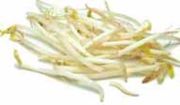
Are typically mung bean sprouts but soybean sprouts are sometimes available. Sprouts have bright silver white bodies with yellow or green heads and small thin hair-like tails. Often used in stir-fry dishes, soups and salads. When buying bean sprouts, choose dry, firm, white spouts. Best when used the same day of purchase but will keep in a refrigerator (in an open bag so that moisture can escape) for a few days. Unsprouted mung beans are small round green beans that are easy to grow. The seeds are usually available in Chinese grocery stores or in health food stores. Soak a quarter of a cup of mung beans in water overnight. Spread a thin layer of the soaked beans on a wet newspaper or cheesecloth on a cookie sheet. Place them in a warm dark area (inside an off oven is ideal). They will sprout and be ready to eat in about five days when the roots are about two inches long.
BOK CHOY (phug gad goung toong)

A white stemmed, loose leafed vegetable in the cabbage family. The stems are usually seven to nine inches tall with a mild, tangy, pepper taste. The trunks are crunchy and the leaves are soft. There is also baby bok choy: young bok choy picked early. Another variety, the Shanghai, has jade green, spoon shaped trunks and curved leaves. Both the baby and the Shanghai variety are sweeter and less fibrous than the regular and are delicious lightly stir-fried to release their natural sweetness. Trim the stem ends and slice the trunks diagonally. The baby bok choy can usually be cooked whole, or cut in quarters or halves. When buying bok choy, look for firm trunks with a bright green color. Store in the refrigerator up to a week.
BAY LEAF (bai gra-waan)
Bay Leaves are available at most supermarket across the country on the spice rack. However, I find that it is more economical to buy them from Indian groceries.
CARDAMOM (luk kra wan)
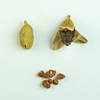
A native of India and Sri Lanka, it also grows in Thailand near the Cambodia border. The green, white or black seedpods must be cracked open to extract the cool, strong scented small black seeds, which are then ground. The pods and seeds are popular in different types of sweet or savory Thai dishes, especially curries. They are often mixed with ginger and boiled, as a health drink. In addition to its culinary role, cardamom has a sexy history as a perfume and an aphrodisiac. Medically, it has been used as a laxative and to relieve indigestion. Europeans have called it Siamese cardamom since the 17th Century. It was one of the first spices exported to England, China and Japan. By weight, cardamom is one of the most expensive spices, exceeded only by vanilla and saffron. As it quickly loses much of its flavor when ground, it's best to buy whole pods and crack them open and grind the seeds yourself. This plant needs a humid climate to grow.
CHILIES (phrik)
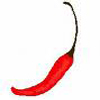
A general rule is: the smaller the chili, the hotter it is and the larger chili is milder. Chilies are rich in vitamin C and are thought to aid in digestion. The hottest parts of the chili are the seeds. Mature chilies are always a darker color than young ones. It is the oil substance called capsaicin, which is concentrated in the seeds and inside the membranes, that make chilies hot. If you accidentally eat chilies and your mouth burns, do not drink water - rice, beer or milk drinks will help relieve the burn. Scientists believe that chilies are native to Central America and that they were brought to Thailand and the Far East by the Portuguese in the 16th Century. This means that Thai food has been "hot" for only the last 400 years. Many Thais are reluctant to believe this, arguing that chilies may have come from across the Pacific or that they originated in Central Asia and were taken by Mongol people to the New World. They also argue that chilies have been used for centuries as a medicine as well as a condiment, to lower blood pressure and cholesterol. According to food scientist Harold McGee, more people now consume chili peppers in larger quantities than any other spice in the world. This is certainly true in Thailand. Even in America, the growing demand (you might even call it a burning desire) for fiery food has made a wide variety of the members of the Capsicum family available fresh. The most common hot chili in Thailand is a small slender chili called prik kii noo or "bird's eye chili," rated the second hottest chili, coming in just under the habanero. The "bird's eye chili" is also known as the "mouse-dropping chili," which has to be the all-time least-appetizing food name. The equivalent chili we suggest is the serrano. It is possible to reduce the heat of a chili by scraping the seeds. Some cookbooks recommend wearing rubber gloves when working with chilies. Be sure to wash thoroughly your cutting board, knives and hands afterwards. Bell peppers are not traditionally Thai, but we use them in our recipes to please the non-Thai palate. In recent years, a chili imported from Mexico called prik khee noo kaset, which has longer pods than prik kii noo, is commonly used in Thai cooking.
CHILES DRIED (phrik haeng)
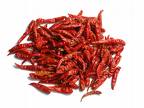
An essential component in the preparation of some Thai curries and sauces. The heat depends on what kind it is, and in most cases you should be able to substitute a dried American or Mexican chili. The seeds of these chilies are very hot, much hotter than the pods. Dried chilies are also hotter than fresh ones. Dried chilies are widely available in Mexican markets and health food stores.
CILANTRO (pak chi) / Coriander, Chinese Parsley, Mexican Parsley

This savory herb with flat green leaves and a refreshingly herbaceous taste is one of the staples of Thai cuisine. Known around the world as an herb and for flavoring, it has been used for thousands of years in Asia. It is delightfully aromatic with a distinct spiced grass/herb taste. This parsley should not be confused with Italian parsley, which has curly leaves. This is much more flavorful and fragrant. Essentially, three parts of cilantro are used in Thai cooking: leaves, roots and seeds. Each has a unique flavor and character. The fresh leaves are plucked off the stem and used as a garnish or mixed into the food. Thai cooks crush the roots and stems into pastes and chili sauces. The Thais seem to be the only people to use the roots in their cuisine. The seeds (mellet pak chee) bear no taste resemblance in flavor to the plant. The seeds are usually found in curries and soups. Cilantro is thought to have originated in the Mediterranean about 3,000 years ago. It is a relative of the carrot. It also features small white or pink flowers. Cilantro is available all year round. If you would like to grow cilantro from seeds, the best time is around March or April. Plant the seeds loosely, cover lightly with soil, expose to light, keep humid and warm until they sprout. When buying cilantro, choose a bunch with fresh leaves and stems. To store, place it into a bowl of water and cover the top loosely with plastic wrap. It will keep in the refrigerator up to two weeks. Cilantro is optional in many recipes. If you cannot find it in your market, or if you do not like the taste, you might substitute flat leaf parsley or even basil.
CINNAMON (op choey)

True cinnamon is the sweetly aromatic dried tan- colored inner bark of an evergreen native to Sri Lanka. Much of what is sold as cinnamon in the Western countries is more strongly scented and darker-colored. In Thailand, the Batavia variety is the most common. It often adds a pleasant flavor and aroma to beef and chicken dishes. Medically, it has been used as an anti-acid and is thought to be able to reduce any overproduction of a nursing mother's milk.
CLOVES (kan phlu)

Made from the dried flower buds of an evergreen tree native to Molucca (one of the appropriately called Spice Islands), cloves impart a sharply heady flavor that is often used to balance the rich flavor of meats. A member of the myrtle family, they can be used whole or in powder form. They are delicious with tomatoes, salty vegetables and ham. In Thailand, cloves are chewed like a candy and as a relief for toothaches. Medically, Thais believe that cloves kill bacteria and control spasms, and that they aid in digestion. This spice is expensive because crops often fail. A Thai favorite, Masuman curry paste features the distinctive bite of cloves.
COCONUT MILK (nam kathee)
Known as the milk of Asia, it is one of the essential foundations of Thai cooking. Coconut milk has a variety of uses: in cooking, sauces, drinks, curries and desserts. It is made in a method similar to that of olive oil. Mature brown coconuts are cracked open. The meat is scraped from the shells and the thin brown skin is removed from the meat. The meat is soaked in water then blended. The meat/water is squeezed and strained to extract as much liquid as possible. The liquid that rises to the top (separating from the water) is coconut milk. The first pressing of the meat is pure coconut milk (hua ga-ti or nam katee "head of the coconut milk"). The milk extracted from the first pressing has the highest fat content (between 17%-18%). Thai Kitchen Premium Coconut Milk is made from the first pressing and may be used in recipes calling for either coconut milk or coconut cream. This process is repeated again using previously squeezed coconut meat to yield a lighter coconut milk (hahng-ti) "tail of the coconut milk." The second pressing of the meat produces a fat content of 6%. Thai Kitchen Coconut Milk Lite has about half the fat and calories of our regular milk. Some recipes call for coconut cream. For coconut cream, use Thai Kitchen Pure Coconut Milk or, for a richer flavor, spoon off the top layer of an unshaken/unstirred can of coconut milk. Coconut milk can be refrigerated for a few days. It should be thoroughly stirred before use. Most sources recommend the following: “refrigerate opened coconut milk for up to a few days or freeze.” In our research conducted in Thailand we found that coconut milk should NEVER be frozen, as the product may permanently lose its ability to emulsify (this roughly translates as suspending fat molecules evenly within the liquid, creating a smooth product). You may have noticed that when you open a can of coconut milk it has usually separated into two layers, the “cream” on the top with a thinner liquid on the bottom. Normally these two layers are stirred together before they are used in a recipe, unless the recipe specifically calls for “coconut cream” (as opposed to “cream of coconut” which is a sweetened product most commonly used in bar drinks). Freezing coconut milk may permanently separate these two components, resulting in a lumpy product that will not smooth out no matter how much it is warmed or how vigorously it is stirred or shaken after thawing. While perfectly safe for human consumption, once thawed, frozen coconut milk will most likely give whatever recipe you put it into an unappealing, curdled appearance. Furthermore, separated frozen coconut milk is particularly susceptible to “freezer burn.”
COCONUT SUGAR (nam tan peep) / Palm Sugar
Coconut Sugar and Palm Sugar (there are subtle differences between them, but they are sold interchangeably) are the most common sugars found in Thai cooking. These basic sugar sweeteners have a caramel, toffee-like flavor and aroma. They are produced from the sap of the coconut or sugar palms much like maple sugar is harvested in this country. Sold in compressed cakes that keep well in a tightly sealed jar, they are widely available in Asian markets. To make palm sugar, sap is collected from various palm trees (most common is the Palmyra Palm), boiled down to a thick syrup, which is poured into bamboo pipe molds. Once dried, it forms into deep brown crumbly round cylinders. These are then crumbled or granulated to a more usable form. Palm sugar adds a smooth, very full-bodied, rich sweet flavor. Thais use palm sugar to balance strong hot flavors such as curries. It complements the spicy, salty and sour tastes of Thai cuisine. Brown sugar can be substituted, although it will not be as rich or intense.
CUMIN (yaa-raa)

Native to the Middle East, (Egypt), it is used extensively in Thai cuisine (as well as the cuisines of Central and South America, Scandinavia, and North Africa). This small rigid, light brown seed is similar to caraway and fennel, and needs to be heated or cooked to release its full flavor. Mainly used for making Thai curries.
CURRY PASTE (nam prik)
)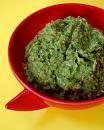
Thais traditionally have made curry pastes fresh daily at home from scratch for their meal preparation. Sitting with a large stone mortar and pestle, the preparer makes small batches, grinding by hand the fresh chilies, garlic, kaffir lime leaves, onion and aromatic spices into a fresh paste. Today, however, modern work schedules have many Thais buying curry pastes from the vendors on the streets or in the market halls. At Thai Kitchen, we use the traditional methods for making our curry pastes so you know you're buying an authentic paste.
CURRY PASTE, GREEN (gaeng keow wan)
Traditionally the hottest of the curries, Green Curry Paste is made with a combination of fresh hot green chili, lemongrass, garlic, kaffir lime and galangal (Thai ginger). Flavor: Spicy and herbal. Suggested Uses: Thai curries are made by simmering curry paste in coconut milk, then adding meat, poultry, fish and/or vegetables. In addition to curry dishes made with coconut milk, Green Curry Paste is great in stir frys and soups. Spice Level: Very spicy.
CURRY PASTE, MASUMAN (gaeng musuman)
A roasted red Thai curry paste made with cardamom, lemon grass, cinnamon, cloves, chilies and other spices with a distinct spicy flavor. Red Curry Paste with a little cardamom and sugar can be substituted.
CURRY PASTE, PANANG (gaeng panang)
A Thai curry paste made with red chilies, onion, garlic, galangal, lemon grass and kaffir lime. A wonderfully complex and interesting flavor.
CURRY PASTE, RED CURRY (gang daeng)
High on the heat scale and very similar to Green Curry Paste, Red Curry Paste is made with fresh red chili, garlic, lemongrass, galangal (Thai ginger), ginger root and onion. Flavor: Spicy chili and ground pepper. Suggested Uses: Thai curries are made by simmering curry paste in coconut milk, then adding meat, poultry, fish and/or vegetables. In addition to curry dishes made with coconut milk, Red Curry Paste is great for satay sauces and dips. Pairs well with tamarind. Spice Level: Very spicy.
CURRY PASTE, YELLOW(gaeng leung)
A milder paste made from yellow wax peppers. In addition to the other Thai herbs used, turmeric is added to enhance the deep yellow color. This curry paste most resembles Indian curry. Many of the influences from their neighbors are apparent in this Thai staple.
EGG ROLL WRAPPER (pan hoa poi pieh)
Thin sheets of dough that are made from wheat flour, eggs, and water. They come in two shapes; round or square. Both shapes are popular. When fried, egg roll wrappers will have a bumpy, crispy and bubbly surface. The wrapper will turn semi-hard. Thicker than spring roll wrappers. (Also see, Spring Roll Wrappers and Rice Paper Wrappers.)
FISH SAUCE (nam pla)

The main flavoring ingredient in Thai cuisine, it is commonly referred to as the soy sauce of Southeast Asia. Fish sauce is a thin, amber-tinted, clear liquid with a salty taste extracted from fermented salted fish (most commonly anchovies). Different combinations of fish (including mackerel, squid, and shrimp) and their quality will affect the taste. The anchovies are salted and placed in concrete casks to age from six weeks to six months. The richly flavored first liquid siphoned from the fermented anchovies is the most prized and is usually reserved for dipping sauces or for special occasions. The anchovies from the first fermentation are usually then used again. Water and salt are added a second time, and the pressed anchovies are fermented again. This lesser quality liquid is used for everyday eating and cooking. Thai Kitchen Premium Fish Sauce is premium quality. That means it is the liquid from the first fermentation of carefully selected premium quality salted anchovies, aged up to 18 months for an extra-rich, smooth, well-balanced, extra-virgin flavor. Thai Kitchen Premium Fish Sauce has no added water. Use it in place of salt or soy sauce to season almost any savory dish or stir-fry. Fish sauce has a distinct pungent aroma. The fragrant aroma will mellow with cooking or when added to food. Although now known as a seasoning of Southeast Asia, the origins of fish sauce trace back to the first millennium B.C. in China. Its popularity declined in China about two thousand years ago due to the popularity of fermented bean and vegetable sauces, precursors to the common soy sauce. Fish sauce is also found in Japanese and Korean dishes. Even the Romans had a taste for it, using a thick, fermented fish sauce called liquamen or garum. Sauces from different Southeast Asian countries yield different flavor characteristics. Vietnamese fish sauce tends to be sweet in flavor. Sugar is usually added to the fermentation process. Philippine fish sauce is heavier to flavor the country's bold, salty and sour flavors. For first time users, the taste and smell will require some time to accept and to get used to. However, once you discover the distinct and complex delicious flavor, you will never want to use salt or soy sauce again. Without this flavor, Thai dishes won't taste Thai. With the growing popularity of the cuisines of these countries, fish sauce is widely available in Asian markets, supermarkets and health food stores. Fish sauce should be refrigerated after opening. Because salt is used in the fermentation process, salt crystals appearing like glass or plastic fragments may naturally form in the bottle. These crystals will dissolve with cooking.
GALANGAL (khaa) / SIAMESE GINGER / GREATER GALANGAL / THAI GINGER

A root similar to ginger, that has a thin opaque cream-colored white skin and dark growth rings on its skin with fibrous, woody pink shoots that grow from the core. The roots are larger and whiter. It grows abundantly throughout Southeast Asia. This rhizome has a distinctively lemony pungency and hot pepper taste. It is also used extensively in Thai cooking grounded with chilies and other herbs and spices to make the base of curry pastes, slices are usually added to fish or soup stocks. The flowers are edible. Thais batter and deep fry the flowers and serve them with a hot chili sauce. It is more commonly available in this country in a dried form. It looks very similar to young ginger. Unlike ginger that is often eaten, the fibrous galangal slices should be removed from the food before serving. It is just for flavoring. The young underdeveloped shoots are sometimes cooked to eat as a vegetable. Galangal has a distinct medicinal, ginger taste. Thais use it in soups to chase the germs of a common cold out of your system. Spice traders brought it to Medieval Europe where it was highly prized, giving its name to the Western cooking term Galantine. It has a history as an aphrodisiac or a digestive stimulant. Mixed with lime juice, Thais use it as a cure for stomach aches. Drinks are made from it to sooth tonsils and the throat. It is easy to grow galangal in the garden with the added benefit of beautiful bright red flowers. If not available, substitute with a combination of dry galangal and galangal powder.
GARLIC (kra thiam)

Almost as ubiquitous as fish sauce in Thai cuisine. White garlic is the most commonly found variety, but recently organic farmers have been reintroducing heirloom varieties. Thais are fond of fried garlic. Garlic is thinly sliced and fried into chips. To make fried garlic, peel and slice garlic, fry in hot oil until golden brown. This garlic is used as a garnish or a topping for any dish. Sprinkle it on top of soups or stir-fries. The oil in which the garlic is fried is saved and used in cooking to give food more flavor.
GINGER (king) / Chinese Ginger

A mildly spiced root, which yields a spicy, aromatic taste. Its unique flavor is another constant in Thai cooking. Ginger is a knobby, brown thick root with a fibrous yellow interior. Young ginger will have a smooth, shiny, golden-yellow appearance with a delicate flavor and is not as stringy as mature ginger. Ginger is known to relieve coughing, nausea and dizziness. It is also thought to aid in digestion. It has a very distinct medicinal flavor. It is used in soups to chase the germs of a common cold out of your system. Widely available in supermarkets, look for firm shiny roots that are not dry or wrinkled. Young ginger is not as widely available but grab it if you come across it. Slice thinly with a mandolin or vegetable peeler, marinate in two cups of rice wine vinegar and a tablespoon of sugar, and you've got pickled ginger. Young ginger is also made into a candied form that is usually sold packed in syrup.
GINGER, PRESERVED (king dong)
Young ginger is cured in salt and water, then soaked in a sugar and vinegar solution for a tangy-sweet, pungent ginger taste that is smoother and sweeter than fresh ginger. Opened jars of pickled ginger should be refrigerated. Thais use preserved ginger in all types of dishes and sauces.
JASAMINE FLOWERS (mali)

Unopened flowers buds, picked in the evening before they open, are used to scent drinking water, teas and desserts.
JASAMINE RICE (khao chao)

Treasured throughout Asia for its inviting aroma and delicate grain, Jasmine Rice is the foundation of Thailand's extraordinary cuisine. This non-glutinous, long-grained rice with its subtle hint of natural jasmine floral flavor is the main staple of the Thai diet. It is a delightful complement to Asian and Western dishes. At Thai Kitchen, we hand select the highest quality Thai Hom Mali Jasmine Rice available for our products. It's the perfect choice anytime your recipe calls for long-grain white rice. Whether you're serving a rich Thai curry or something hot off the grill, a steaming bowl of jasmine rice with its naturally delicious flavor turns any dish into a satisfying meal, quickly and easily. Almost all the jasmine rice grown in the world is from Thailand. The tremendous demand from world markets has made this one of Thailand's most prized staples and main export items. This unique premium variety can only be grown in the lush tropical climate of Thailand’s Northeastern region. Harvested just once a year from Thailand's fertile central plains, you'll agree jasmine rice could be the most delicious rice you will ever eat. Thai Hom Mali Rice is the indigenous jasmine rice of Thailand. Thai Hom Mali Rice is internationally recognized for its pure white long-grain, natural jasmine fragrance, soft texture and distinct taste.
KAFFIR LIME (ma grut) / Thai Lime / Wild Lime
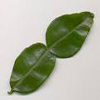
In Thailand almost every part of this plant is used in cooking. It is quite different from the lime that we are used to seeing here in the USA. The fruit has dark, wrinkled, bumpy skin, which is used in the preparation of Thai curries. The leaves are highly prized for the unique citrus-floral note that they impart to soups and curries. The flavor is unique with its citrus-floral, lemon, geranium taste and scent. The peel and leaves can be found in Asian markets in dried form; if unavailable, the best alternative is lime zest. Most of the limes that appear in American markets are the Persian limes. When the recipes on this website call for lime juice, the juice of either lime is fine. Kaffir lime is difficult to find in the continental United States. It has been successfully grown on the Hawaiian Islands and has been experimentally grown in California for over 65 years. With the popularity of Thai food and the increased knowledge and demand for this unique citrus fruit, more growers have started growing and carrying them in the United States. It is possible to grow your own tree indoors or outdoors in moderate climates. Some Asian markets and Thai stores now grow and sell the seedlings. Kaffir lime is a very slow growing plant; it does not bear fruit until it is eight to ten years old. The juice is usually squeezed over dishes to give it a tangy flavor, the peel and leaves are ground and used in curries or in soups to give them a lime zest. Historically, the Thais used the juice in ointments and shampoos, and the peel in tonic medications. It was thought that the distinct essence drove away evil spirits. You will see fewer and fewer references to “kiffir” lime leaves, as the term is derogatory in Arabic and some southern African languages. Many recipes now will refer to wild lime leaves or ma grut.
LEMONGRASS (ta krai)

A lemony and fragrant herb commonly found in Thai soups and curry pastes. The flavor of lemongrass is one of the essential tastes of Thai cuisine. Lemongrass grows in tall thick stalks with tough outer leaves that sheath a tender inner core. This woody yellow green stalk resembles tall (12"-24") fibrous grass blades. Only the moist, juicy bulb-like, white-yellow portion or the bottom 2"-3" few inches of each stalk are used for cooking. To cook with lemongrass, cut off the bottom moist portion of each stalk and discard the fibrous trunks and leaves. This bottom portion should be bruised with the back of a knife and then cut or sliced into smaller pieces so that its woodsy/lemon-perfume flavor is easily released during cooking. Use lemongrass like a bay leaf or a cinnamon stick to flavor dishes. Finely minced, it can be included in curry pastes and sauces. Since lemongrass is fibrous, and difficult to swallow, remove large pieces from your dish before serving. Fresh lemongrass may be difficult to find and is optional in many of the recipes except for those in which it is the primary ingredient. Since there is no perfect substitute for this unique flavor, leave it out of your dish and allow your other ingredients to convey your Thai flavor. Some substitutes are: lemon zest with small amounts of fresh ginger (approximately 1/2 Tbsp. combination total for 1 lemon grass stalk), a few leaves of lemon balm or lemon leaves (approximately 2 leaves for 1 lemon grass stalk). In Thailand, lemongrass soup is used in place of chicken soup as a home cold remedy. Thais will also chew on the ends of the lemongrass stalks to induce a sweat to cure a cold and to relax. Lemongrass is commercially grown in India, Australia, Africa, South America and the United States (Florida and recently California). It is possible to grow lemongrass in other parts of the United States. Check with your local nursery or plant shop.
LONG BEANS (thua fak yao) / Chinese Long Beans

Botanically closer to the black-eyed pea than green beans, the long bean grows to a length of two to three feet. Chopped into pieces, it can be stir-fried, deep-fried or included in a stew or curry. In Thailand it is often minced and used as an ingredient in dressings and curries.
MACE (dawk chand)
The orange outer covering of nutmeg which is the fruit of the evergreen tree native to Indonesia.
MINT (bai sa ra nae)

Though closely related to the ubiquitous basil, mint is not nearly as widely used. Its introduction is said to be a result of the spread of Vietnamese cuisine. Thais use mint as a garnish, a vegetable and a flavoring agent to add that last little grace note of bracing coolness. Spearmint is the most commonly used variety in Thailand. The mint is similar to the mint grown in England.
MUSHROOMS, SHIITAKE (het hom) / Chinese Black Mushrooms

Japanese shiitake and Chinese black mushrooms are similar varieties, used dried. The Japanese mushrooms have a slightly salty, musky, meaty flavor. Both varieties need to be soaked in hot or cold water for at least half and hour to hydrate and soften before using. The longer they soak, the softer they become. After soaking, trim off the knobby, woody stem ends before using. These mushrooms are delicious when stir-fried with vegetables. They are thought to stimulate the immune system, promote blood circulation, and lower cholesterol. Chinese black mushrooms are a cousin of the Japanese shiitake mushroom. They look similar in appearance, however, they have light tan creases on their cap. The Chinese black mushroom has a wild mushroom flavor slightly different that of the shiitake. These mushrooms are slightly less expensive than shiitake.
MUSHROOMS, STRAW (hed fang)
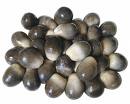
Small delicate brown mushrooms with a sweet and meaty taste. They come in two forms. One form resembles small brown eggs. The cap of the mushroom encases the whole body and the stem. The peeled variety has a dark brown, domed-shaped cap and a short, thick stem. These mushrooms grow in rice straw (which gives them their name), and are available all year. Straw mushrooms are also commonly sold in cans. To use them, drain the can liquid and rinse the mushrooms with cold water. You might want to soak the mushrooms in cold water and salt for about 20 minutes to remove the canned taste.
NUTMEG (luk chand)

It is the seed of an elegant low growing tree that is native to the Moluccas Islands (Spice Islands) and all over Indonesia. The beige colored oval nut is protected by an orange-red, fibrous, strong, hard, web-like outer husk that is removed and processed to make mace. The nuts are slowly dried above a smoking fire for six weeks. This adds to their fragrant and sweet qualities. Popular in Europe since the 16th century. In Asia, nutmeg is a important ingredient for making curries, sauces and spice mixtures. It is often used in desserts, sweetmeats and to make Musuman curry paste (see, Mace).
ONION (hua hom)

The onion family includes garlic, leeks, shallots, scallions and chives as well as a diverse selection of red, white, yellow and sweet onions.
OYSTER FLAVORED SAUCE, CHINESE (nam mun hoi)
A thick brown sauce that is commonly used as a base sauce in Chinese food. Made from fermented oyster extracts and spices, it has a distinct and pleasant smoky-sweet flavor. Used in Chinese cuisine since 1888. Does not taste like oysters at all. The meaty, gravy taste gives food a distinct Chinese flavor.
PRAWNS, TIGER (kung kula dam)

They have distinctive black and white stripes and are the largest among Asian prawns. These giant prawns can grow over twelve inches long. Large shrimp can be substituted. (see, Shrimp).
RADISH, SWEET PRESERVED (Hua Pak Kad Wan) / Preserved Turnip
Sweet preserved radish is made from salted and pickled (daikon) turnips. It gives authentic Pad Thai noodles its distinct sweet and salty, tangy, savory apricot-fruit flavor. It is also commonly used to add flavor and a crunchy texture to soups, braised meat and vegetable dishes. In Chinese dishes, it is frequently added to congee or used as a stuffing in dumplings. Sold in vacuum packs in Asian markets, they are available in many different sizes; shredded strips, whole pieces and flattened elongated pieces. The pieces are a brownish color, and sometimes speckled with salt. There are two varieties; one is highly salty, the other less salty and slightly sweetened and commonly used in many Thai dishes. Look for the words "sweet" or "sweetened" somewhere on the package to make sure you are getting the right one.
RICE NOODLES, DRIED (kui teow)
Made from rice flour and water, steamed until cooked, and then dried. Flat and slightly translucent, Thai Kitchen produces two varieties. All are dry and must be soaked or boiled before using. Thai Kitchen Thin Rice Noodles [also known as Rice Vermicelli (sen mee), Claypot Noodles, Soup Noodles] are thin vermicelli noodles that are delicious served cold with a spicy topping, stir-fried, or a pleasing addition to soups. Thai Kitchen Stir-Fry Rice Noodles (also known as Rice Stick, Pho Rice Noodles) are linguini-width, perfect for Pad Thai and other stir-fried dishes. Rice noodles can be used in place of rice for curries and stews. Rice noodles, when dried and packaged, resemble tangled rolls of string. All varieties are delicious for stir-frying or soups. They can be fried and used as a garnish for salads. For frying, there is no need to soak the noodles. They are fried in a dry stage. They are ready in a matter of seconds. They will keep for years, stored in a cool, dry place. These noodles are wheat-free, fat-free, cholesterol-free, egg-free and are a healthy option for people with allergies or special nutritional needs.
RICE NOODLES, FRESH (sen yai)
Made from rice flour and water, and steamed until cooked. These are the same noodles that are commonly sold dried, but are packaged fresh before the drying process. The taste and texture will be slightly different. Since they are fresh, to prevent them from sticking together, the noodles are coated with oil. Fresh rice noodles are soft and, white, resemble sheets of white jello and are often sold in folded sheets. You can cut these sheets into the size noodle you prefer. These noodles are often sold on the counter of Asian markets or in the fresh department wrapped in cellophane. They are delicious for stir-frying or soups. They will dry quickly or become hard in the refrigerator. Place them in warm water to soften them before cooking. Best when used the same day of purchase but will keep in the refrigerator for several days. Wheat-free, gluten-free, cholesterol-free, egg-free.
RICE PAPER WRAPPERS (pan hoa poi pieh)
Paper-thin, semi- transparent, hard rice sheets made of rice flour and water that are used for fresh or fried "eggroll-style" rolls. Commonly used in Vietnamese cuisine for the popular, not fried, spring or shrimp rolls. They come round or in triangular shape. To use these wrappers: just before rolling, individually soak them in a shallow dish with water or place them between two generously damp towels for 30 to 60 seconds to soften, lay them on a flat surface, stuff them with your favorite goodies and roll. Wrappers are made with the same ingredients as dried rice noodles. Since they are steamed-cooked before being dried and packaged, they can be eaten after they are soaked and softened. Most commonly eaten unfried; however, these wrappers can be fried for a light, crispy, smoother roll (not bumpy like egg rolls). Similar to spring roll wrappers but not made with wheat or egg. If you like rolls and don't want the fat from frying, these wrappers are delicious alternatives as you can enjoy 'rolls' without the frying. Since these rolls are commonly referred to as spring rolls in restaurants, ask your server before ordering whether they are fried or not fried. (see also Eggroll Wrappers and Spring Roll Wrappers.)
ROASTED RED CHILI PASTE (nam prik pow)
Both an all-purpose condiment and versatile seasoning, Roasted Red Chili Paste is a concentrated blend of slowly roasted red chilies and authentic Thai spices. Roasting the chilies provides a mild, well-balanced spicy flavor and the dried shrimp provides a hint of seafood taste. Made with an authentic blend of roasted red chilies, garlic, onion, anchovy extract, dried shrimp, tamarind and peanuts. Flavor: Spicy-sweet and smoky seafood. Suggested Uses: Adds complexity to any number of dishes. Use as a stir-fry seasoning, a soup base, or as a condiment for rice, vegetables, a spread for crackers, noodles or chicken. Add a teaspoon to your marinades for an extra kick. Can be substituted in recipes calling for Asian spicy bean sauce, spicy soybean paste, mild chili paste or spicy bean curd paste. Spice Level: Moderate spicy.
SESAME OIL (num man nga)
Made from the pressing of toasted sesame seeds. The color of the oil depends on the color of the toasted seeds. Sesame oil is usually dark amber or a golden copper color. Should not be confused with the clear cold-pressed sesame oil sold in many health food stores. Sesame oil should be used solely as a flavoring agent and not for cooking. Many people often want to stir-fry with this oil when preparing Asian dishes. This is a mistake and will ruin your dinner. This oil is a very thin oil and will char and burn with high heat; leaving your dish with a burnt taste. Use heavier oils such as peanut, corn or soybean for stir-frying. Sesame oil adds a wonderful taste and aroma to your food and should be only drizzled on top of your finished dish just before serving. It is also delicious as a salad dressing oil.
SESAME PASTE (gnaa)
Toasted white sesame seeds are ground to form a peanut butter-like paste. The flavor is rich and nutty with a definite concentrated sesame flavor. Colors range from brown to golden brown. This paste is used to add a nutty flavor to soups and seasonings. In Middle Eastern food, a similar paste called tahini is made from untoasted white sesame seeds.
SHALLOTS (hom lek)

Resembling a small red onion, the flavor gives Thai food a distinct Thai quality. These slender, pear shaped bulbs with long necks and skins can range in color from grey to copper and are more intense in taste than regular onions. They have a mild, sweet, delicate, richer flavor. They are grown in small clusters and are seasonal. They do not keep as well as regular onions and are mostly used for flavoring rather than as a vegetable. Browning shallots will make their taste bitter. A good substitute is the white portion of green onions or, of course, regular onions.
SHRIMP (khung)

Thailand's Gulf Coast is home to the giant shrimp that are dignified with the name prawns. Large shrimp and prawns are identical; however, varieties from different parts of the world may have different qualities. Tiger prawns are one particular variety often used by name on many menus (see, Tiger Prawns).
SHRIMP DRIED (khung haeng)
Tiny shrimp are soaked in water and salt, then dried. These bright orange-colored shrimp have a strong shrimp-salt taste and are slightly chewy. The distinct shrimp flavor is often used in soup or stir-fry dishes; it is a flavoring agent in both Thai and Mexican cooking. Typically ground or pounded with other ingredients in a curry paste or sauce, dried shrimp add an intense seafood flavor to food. Usually sold in small packets. Look for brightly colored shrimp; seal and refrigerate leftovers. Available in Asian and Mexican markets. Use in their dry state or soak to soften them for cooking. A small amount will add a lot of flavor.
SHRIMP PASTE (kapi)
Salted fermented shrimp are ground together to form a pungent, strong flavored fish paste that is a pinkish grey color. Some may find the smell of shrimp paste an offensive odor. Before you open a the bottle or package, be prepared for the strong aroma that will soon dominate your kitchen. However, once cooked the smell transforms into a fragrant and aromatic delicious fish and salt taste that is impossible to duplicate. The fresh paste is rose pink and the dried varies in shades of grey/pink/beige. Both are made from ground salted shrimp. The dried, more pungent tasting is dried in the sun so that the moisture is evaporated and the paste is more concentrated. The dried does not need to be refrigerated; however, the fresh should be refrigerated. Rich in vitamin B, it is the main source of protein for most Asian diets.
SOY SAUCE (si iu)

An ancient seasoning first developed in China more than 3,000 years ago. It is a dark brown liquid with a salty taste. Made by fermenting soybeans and mixed with a roasted grain (usually wheat, barley or rice), it is then left in vats for a few months to ferment. The Japanese adopted the process about four centuries after the Chinese. Chinese and Japanese soy sauces have different flavor characteristics and profiles. There are many versions of soy sauce in China with taste profiles that reflect the taste of that particular region. Japanese soy sauce is characteristically sweeter than the Chinese type. However, all soy sauces differ in flavor and color, and vary from light to dark, from thick to watery. Like wine, experiment with different types to find one that suits your taste. Soy sauce is a good substitute for fish sauce when making dish vegetarian.
SPICES (kreung phrong)
The classic spices associated with Asian and South Asian cooking actually play a less prominent role in Thai cuisine. Thai curries are usually pastes made from fresh herbs and vegetables as opposed to the Madras curry of India that is a blend of various spices ground into a powder. The recipes in this book call for a number of spices.
SPRING ROLL WRAPPERS (pan hoa poi pieh)
Are thin sheets of wheat, eggs and water. Shapes will vary from round, square or rectangular. Made from the same ingredients as eggroll wrappers, but are much thinner. When fried, they will have a smooth surface, crispy-hard texture. (Also see, Spring Roll Wrappers and Rice Paper Wrappers.)
STICKY RICE (khao niew) / Glutinous Rice, Sweet Rice

Not as common to the Western table but widely used in Southeast Asian cuisine. In Northern Thailand, sticky rice is steamed and eaten out of hand by scooping up a small portion and slipping it into the curry or other dish, using rice to grasp a piece of meat or vegetable. Sticky rice is also commonly cooked with coconut milk and sugar and served with fruit such as mangoes for dessert or used to make sweet puddings. The short-grained, semi-oval, pearl-shaped, white variety is most common. There is also a black variety that is used only to make desserts. When cooked, sticky rice is soft, moist, sweet, sticky and semi translucent. It is often wrapped up in lotus leaves and stuffed with meat. The Japanese pound cooked glutinous rice to make mochi cakes. This rice is usually steamed not boiled. For best results, soak the grains in water for several hours or overnight; drain all water before cooking.
SWEET BEAN SAUCE (see euw)

A rich and full-bodied sauce made from the fermentation of soybeans and sugar. Thais often mix in additional sugar and rice vinegar and add chilies to make a condiment for noodles and appetizers. There are many different consistencies, from a liquid to a paste. Thai sweet bean sauce should not be confused with bean sauces from other Asian countries as they differ in taste.
TAMARIND (som ma kham piak)

Tamarind provides the complex fruity and sour taste that is evident throughout Thai cuisine. The flavor is close to sour prunes or a very fruity mild vinegar. It is commonly used in Thai curries, soups and stews. Pods that resemble large peanuts with a hard, smooth and furry brown shell grow on the tamarind tree. The pods are originally green and turn a rich, dark brown color when ripe. Thais eat unripe pods with sugar, salt and chili flakes. They also roast the seeds and use them to flavor young coconut or palm. The pods contain a dark brown, veiny pulp, the consistency of a raisin pulp, surrounding the seeds. The taste of tamarind is most familiar to Western palates as one of the main ingredients in Worcestershire Sauce. Tamarind paste is available from Asian and Indian markets but may be still difficult to find. Tamarind is usually sold in a paste form or as a brick or in jars of concentrated pulp. To use in food, the fleshy pulp must be removed from the fibers and seeds - which is no easy task. When a recipe calls for tamarind, it usually refers to tamarind juice. The juice is used as a souring agent (see: Tamarind Juice). Thais eat tamarind directly from the pod for use as a diuretic. There is no need to worry, tamarind is in a very diluted form when used in food. The taste is impossible to duplicate. Translated from Arabic, tamarind means Indian date.
TAMARIND JUICE/PASTE (nam som ma kham)
Concentrated tamarind pulp is sold in small blocks in Asian markets. To use the pulp to make tamarind juice, soak or boil the concentrated pulp in water and use the resulting liquid for cooking.A good standard proportion is 1 part tamarind pulp concentrate to 8 parts of water. (Example: 1/4 cup concentrated tamarind pulp with 2 cups of water). If you like a stronger flavor, reduce the amount of water. First, boil the concentrated pulp for 5 minutes or soak it in cold water for 1 hour. Work the mixture with your fingertips or spatula until soft, then strain in a strainer or a coffee filter to remove the pulp and extract the liquid. You may want to squeeze the pulp to extract more liquid. It is usually this liquid that you use for recipes.Measure out the amount of liquid in the recipe and refrigerate or freeze the remaining tamarind juice for future use. (For a lighter tamarind juice, you can soak the pulp in more water). Or, substitute fresh lime juice for the sour taste. Use 1 1/2 tsp. of fresh lime juice for 1 tsp. tamarind paste in a recipe.
TAPIOCA PEARLS (sa khu met lek)

Come from the root of the cassava plant. These are very small opaque balls used to thicken sauces as well as puddings and desserts. They become transparent when cooked. (Also see, Tapioca Starch / Flour).
TAPIOCA STARCH / FLOUR (Dang Noi or Man Sum Palung)
Comes from grinding the root of the cassava plant which is native to South America. An off-white colored starch that is also known as tapioca flour or flower, it comes in many textures from fine flour to a small round granular form known as tapioca pearls. It is often combined with rice flour or wheat starch to add strength to dough or to thicken sauces. Chefs prefer using tapioca starch to thicken sauces because it is more stable for reheating. Cultivation of the plant in Asia began in the 1800's. The raw root contains toxic portions of hydrocyanic or prussic acid, but once cooked and processed is safe for consumption.
TARO ROOT (puak)
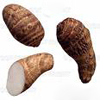
This rough, dark skinned and hairy textured root comes in many sizes, from large melon to small baseball. The meat core will vary in color from white and gray to light purple when cooked. The meat is starchy in texture with a mellow sweet crunchiness. The root is very similar to potatoes in texture and appearance. Taro grows wild in Thailand along river banks and lakes. It is most prevalent in Northern Thailand. The young leaves are also eaten. Taro root is commonly used to give seasonings and sauces texture and a mild sweet flavor.
TOFU (toa hua)
As more Americans become familiar with it, tofu or bean curd is no longer just a cultural cliche for blandness. Prepared as part of an intensely flavored dish (and Thai food is definitely intensely flavored), its ability to absorb the flavors of what is being cooked make this high-protein and low cholesterol food tasty and healthy. There are many different forms of tofu - puffs, sheets, sticks, blocks. The most common are the white shaped blocks. Tofu blocks come in many different textures - soft, firm, hard, and spongy. Different water densities will determine the texture. Tofu is made from ground soybeans and water, the juice extracted from the meat. The liquid is then cooked and let to stand to form the tofu block. Tofu can be eaten hot or cold. It is often served with sauces that are easily absorbed. Clear white colored tofu is the best. Tofu will keep in the refrigerator for a few days. Discard any tofu that develops a strong odor or changes in color.
TURMERIC (kha-min)

A small bright orange root that provides the yellow coloring for curries and other dishes. Turmeric is commonly available in powder form. There is also a white version about the same size as common ginger. It has a slightly peppery and pleasant tang. The flowers are used as a vegetable and are stir-fried or steamed.
VEGETABLES, PRESERVED/PICKLED (puk dong)
There are many different varieties of preserved vegetables. Preserved or pickled vegetables usually have a pungent sweet-salty, vinegar taste. Many are pickled with chili for a spicy taste. There are many different ways of preserving vegetables - as you will see in the taste. The most common methods of preserving/pickling use vinegar, salt, water and chilies. These vegetables are used to add a crunch, saltiness, sweetness or a distinct flavor to soups, stir-fries, just about anything you are cooking. They are also served as a side dish with the main course.
RICE VINEGAR (num som sai choo)
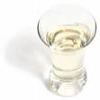
Usually golden in color, this vinegar has a sweet, light, fuller flavor than regular distilled white vinegar. The taste is quite different from that of regular vinegar, which has a strong acid taste. Compared to vinegars that are usually made by fermenting cider, wine or malt, rice vinegar is made by the fermentation of rice and is less tart and sour. The color is usually clear or slightly golden to light amber. Some rice vinegars contain sugar.
WATER CHESTNUTS (haew)
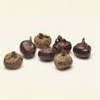
Small round bulbs with papery brown-black skin and a tubular pointy top. Water chestnuts seem more related to a flower bulb than their hard-shelled namesake. Inside is a sweet, slightly starchy flesh. The crunchy flesh of fresh water chestnuts has a sweetness that you just don't get in the canned version. However, both fresh and canned water chestnuts retain their crunchy texture long after they are cooked. Jicama is a good substitute. For some reason, many food writers seem compelled to describe peeling fresh water chestnuts as a fiendishly bothersome task. Not so. Rinse fresh water chestnuts well with water to remove any mud. Slice off the top and bottom and go around the middle with a paring knife. Peel the brown skin off to reveal the white flesh. Cut, chop to your desired taste. Place in a bowl of water to prevent discoloration. Peeled water chestnuts can be frozen up to a month. Rinse canned water chestnuts under water and blanch them in boiling water to eliminate any can taste or off flavor. Canned water chestnuts should be transferred into a tightly sealed container, filled with water and refrigerated. They will keep up to a week if the water is changed daily. If you're buying them fresh, feel each one and make sure it is firm. Unpeeled they'll keep about two weeks in the refrigerator.
WILD LIME: (See Kaffir Lime)

You will see fewer and fewer references to “kiffir” lime leaves, as the term is derogatory in Arabic and some southern African languages. Many recipes now will refer to wild lime leaves or ma grut.